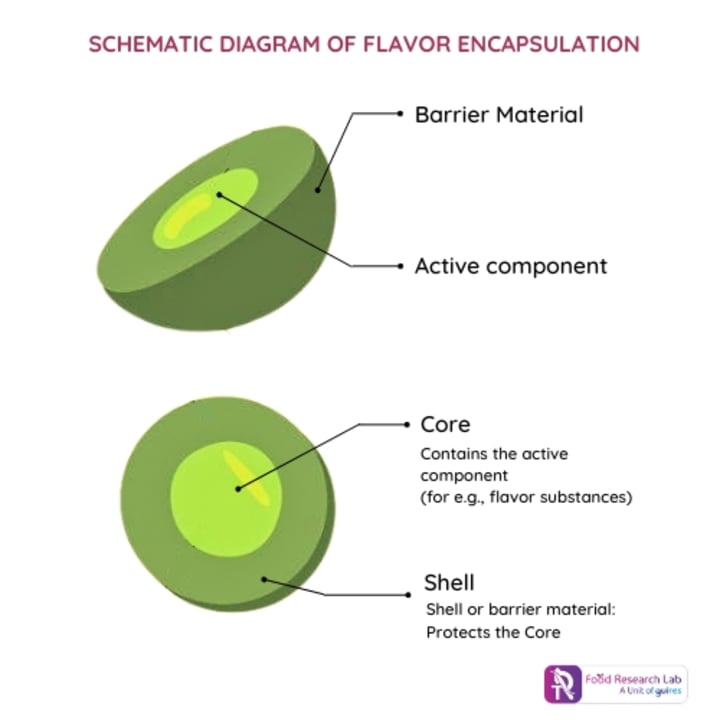Introduction
The flavour is an important factor that influences food quality and acceptability. The effective creation of new food products necessitates the delivery of flavours in a way that preserves their stability and quality. However, due to their sensitivity to air, heat, and light, susceptibility to evaporation, and poor solubility, most flavour substances are low molecular mass volatile chemicals, and stabilising them during processing and storage remains a key difficulty in some food applications. To solve this issue, encapsulation technology has been developed. Flavour substances are trapped in carrier or wall materials during encapsulation, and the trapped flavour substances are referred to as core or active components. The wall material in this design works as a physical barrier between the sensitive core component and the outside environment, preserving the stability of the flavour compounds during food preparation and storage.

Encapsulation process
1. Selection of the wall material
Encapsulation walls or carriers are made of biodegradable, food-grade fats, proteins, or carbohydrates.
2. Incorporation of the flavor
The flavor components are combined with the encapsulating material of choice. This can be accomplished by using several processes, such as spray drying, freeze drying, extrusion, coacervation, and emulsification.
3. Solidification
Cooling, drying, or curing solidifies the encapsulated mixture, generating microcapsules or nanoparticles.
4. Purification
The encapsulated particles are collected, and any leftover solvents or unwanted components are removed.
Advantages of flavor encapsulation
Protection
Encapsulation protects flavour substances from oxygen, light, and temperature fluctuations, which result in degradation and loss of flavour quality.
Longer shelf life
By reducing the release and evaporation of flavour ingredients, encapsulation helps to extend product shelf life.
Sustained release of flavour compounds
The encapsulation method allows for the regulated release of flavours, resulting in a more consistent and satisfying sensory experience.
Better Solubility
Encapsulation can improve the solubility of hydrophobic flavour compounds in aqueous conditions, broadening their applications.
Customisation of flavours
The encapsulation method allows for the customisation of flavour release rate and strength, allowing product makers to create unique flavour profiles.
Versatility
Encapsulated flavours can be used in various products, such as beverages, confectionery, baked items, and dairy products.
Applications of flavour encapsulation

Coffee
Coffee aroma compounds are made up of furans, ketones, pyrazines, and pyridines, among others, found in extracted oil from roasted coffee. As flavouring agents, these substances enhance the aroma. They require encapsulation to maintain freshly brewed coffee flavours because they are composed of various unsaturated fatty acids that are susceptible to oxidation.
Yoghurt
Fruit flavour encapsulation in yoghurt aids in the preservation of aroma and taste. When consumed, the encapsulated flavours are released, boosting the sensory experience.
Ice cream
Encapsulation is used in ice cream to prevent flavours from temperature changes and retain the intensity intact throughout storage.
Salad dressings
Encapsulation can be used to infuse herb or citrus flavours into salad dressings, offering a consistent flavour experience [1].
Conclusion
Encapsulation technology for flavour is employed to address the limitations of flavours in food and beverage products- susceptibility to oxygen and temperature variations and lack of solubility. In the encapsulation process, the flavour or the active component is enclosed in a wall material, which can be derived from carbohydrates, fats or proteins. Encapsulation helps improve the shelf life of flavour compounds, enables sustained release and can be used for various food and beverage products like coffee, ice cream, flavoured yoghurt and ice cream.
How the Food Research Lab can help
We are a team of food scientists who assist in flavour and fragrance development for food, beverage and nutraceutical products. We keep updated with the latest trends in the food industry and help our clients develop new and exciting products that are delicious yet wholesome. We abide by the regulations and ensure that only top-notch products are developed, guaranteeing success.






Comments (1)
Wonderful work!